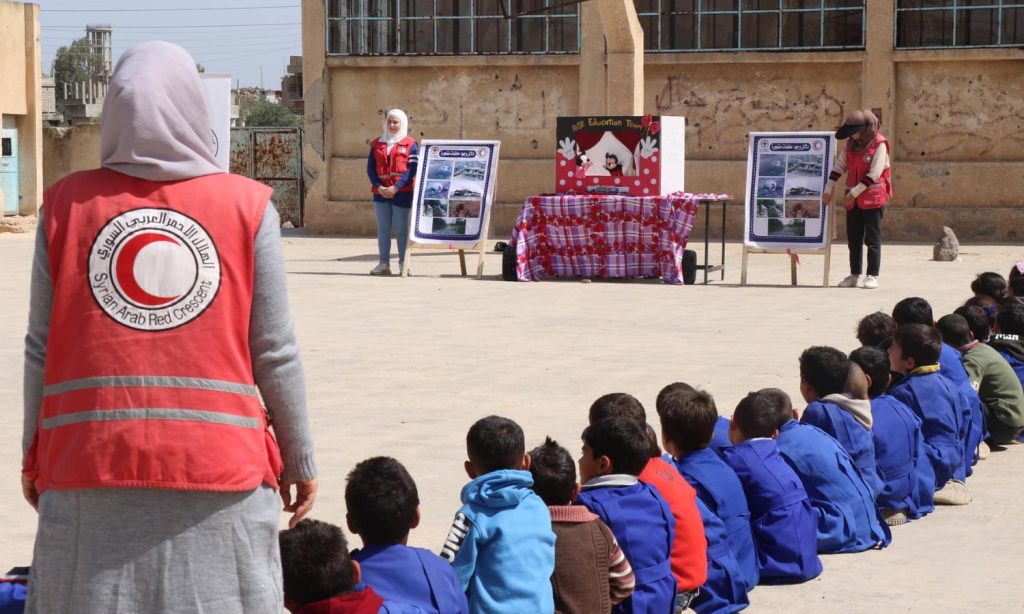Daraa – Sarah al-Ahmad
Unexploded ordnance is spread over large areas in Daraa governorate, southern Syria, and varies between mines and unexploded cluster bombs.
Remnants of war lie in populated areas, which have witnessed repeated bombardment by the regime forces over the past ten years.
Mines are also spread in the agricultural plains surrounding the military barracks of the regime, as they were planted during the battles against the opposition factions in the absence of any efforts by the Syrian regime to remove them.
Most of victims are children
“Since his injury, my son has not returned to his normal state,” Muna al-Sayasneh told Enab Baladi.
Aghyad, 13, of Daraa al-Balad town, was injured by a landmine while he was inspecting his house, which the family left due to military operations, which caused him to lose his normal life.
Aghyad is not the only child who was injured in the city of Daraa as a result of the remnants of war, as the month of April 2022 witnessed the death of two children as a result of the explosion of these remnants and a third child was killed in July 2022 in the same way.
Al-Sayasneh said that her family did not know that there were remnants of war in the vicinity of the house, and while her son was playing, she heard the sound of an explosion, and his treatment process continued for many months in Yarmouk Hospital in Daraa.
Since his injury in February 2022, the mother has not been able to obtain a prosthetic limb for her child, which greatly prevents him from practicing his normal life.
In 2020, the child Issa was injured as a result of a mine explosion in Daraa governorate, and he lost his left eye and two fingers on his left hand, and his right hand was amputated, the mother told Enab Baladi.
Issa underwent many operations in hospitals in the cities of Daraa and Damascus, and he suffered a lot of pain.
According to a report by the Euro-Mediterranean Center for Human Rights, Syria has been heavily contaminated with landmines “as a result of the war that began in 2011.”
According to the report, 2,637 civilians, including 605 children and 277 women, were killed as a result of mine explosions between March 2011 and March 2021.
The report indicated that although all warring parties have used landmines in Syria and are responsible to varying degrees, the Syrian regime is primarily responsible, given its military equipment, economic resources, and the diversity of its armament.
Continuous treatment despite high costs
The high cost of treatment for injured children is one of the most prominent problems that their families suffer from, as it reaches millions of Syrian pounds amid the absence of any support from the government of the Syrian regime in Daraa, with the exception of activities carried out by the Syrian Red Crescent on the International Day for Mine Awareness, including hosting injured children and distributing gifts and entertainment activities.
Hazem, one of these children, the cost of his treatment amounted to about 24 million SYP, distributed between the costs of surgeries and physiotherapy.
Hazem was exposed to a bomb explosion from the remnants of war in 2022, as a result of which he was seriously injured, lost his left eye, and underwent plastic surgery, including the installation of an artificial eye lens, which is replaced on a monthly basis.
Hazem’s mother, who was also injured in the same explosion, said that her child underwent several surgeries at the French Hospital in Damascus, and the treatment is still continuing without any financial assistance from the Syrian regime’s government or other organizations.
The Syrian regime had previously signed a memorandum of understanding with the United Nations to support demining efforts in July 2018. However, remnants of war are still scattered in various governorates, including Daraa, without serious moves to remove them, which leads to an increase in the number of casualties.
In April, a remnant of war exploded in the town of Sheikh Maskin in rural Daraa, seriously injuring five children.
According to the Syrian Network for Human Rights (SNHR), at least 30,034 children were killed in Syria by various parties to the conflict from March 2011 to June 2023, and it stated that Syria is one of the worst countries in the world in terms of the amount of mines planted since 2011, despite the prohibition of their use by international law.
The death toll from mines in Syria reached 598 children out of 2,601 civilians killed.
Daraa, according to SNHR, ranked fourth as the city in which civilians were most affected by mines.
Mines are considered a weapon available to various parties to the conflict due to their ease of manufacture and low cost, which enabled the parties to the conflict to use them widely without announcing their locations or trying to remove them, which extends their danger for decades and threatens the lives and movement of Syrian citizens, especially children, according to the report.
In May 2022, the Global Protection Cluster issued a report on explosive ordnance (remnants of war) in Syria and the threat it poses to the lives of the population, warning that it puts one out of every two people in Syria at risk of death and injury, and impedes the delivery of vital humanitarian aid.

